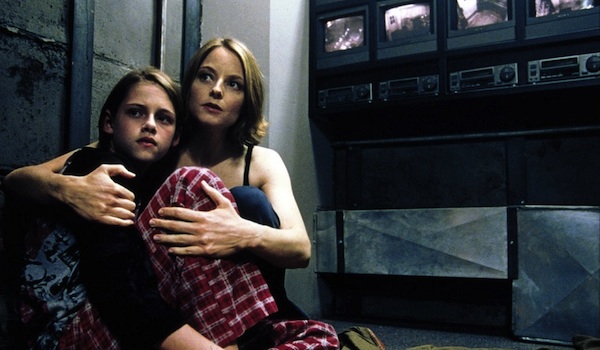Panic Room Review
Panic Room is arguably David Fincher’s most problematic film. Yet, this is a rare instance in which the technical aspects of the film are so admirable and strong that you can overlook the massive narrative hiccups and actually enjoy the end product. Too often, the needs of the plot drive the actions of the characters. But Fincher’s expert ability to build tension, as well as the film’s dynamite art direction, cinematography, and score, are enchanting. I wish the story matched these aspects in terms of quality, but the director has enough fantastic work throughout this filmography that a minor success like this is permissible and understandable.
Meg Altman (Jodie Foster) is searching for a place to call home. After divorcing her adulterous millionaire of a husband (Patrick Bauchau), she and her daughter, Sarah (a pre-Twilight Kristen Stewart) decide to start over. They place they choose is an incredible brownstone on the Upper West Side of New York. The home is a dream—it’s got multiple levels, beautiful hardwood floors, and an elevator. It also has a panic room—a place where you can safely hide from intruders. The panic room is surrounded by solid steel, has a separate phone line and ventilation system from the rest of the house, and is for all intents and purposes completely impenetrable from anyone outside it. Meg is creeped out by the panic room, but recognizes it as a necessity. And when three men break into her house, she holes up in the room with her daughter. Unfortunately for Meg and Sarah, the thing these men came for is in the panic room with them, and they aren’t leaving until they get it.
The lion’s share of my dissatisfaction with Panic Room lies with David Koepp’s screenplay. Credited writer of such cinematic gems as Angels and Demons, Indiana Jones and the Kingdom of the Crystal Skull, and Spider-Man, I might be unfair to expect the story to be airtight. But the holes are too massive to forgive him too easily. Only in the movies do burglars break in to a creepy house the very day a single mother moves in, and only in the movies do they do so because one of them thinks to countdown the days until she moves in business days. Only in the movies would the robbers leave the panic room door unguarded, and only in the movies would complications arise to force Meg to leave the room multiple times. The film tests the limits of plausibility a few too many times. But I really wish it hadn’t because everything else about it is really good.
Like many of Fincher’s films, his direction stands above everything else as the film’s greatest positive. Sure, much of the gamesmanship between Meg and the robbers feels manufactured, but Fincher makes the most out of it, milking these situations for maximum suspense. I was on the edge-of-my-seat throughout, and though I felt frustrated often, I admired what the director was able to accomplish even more.
The film is also a master class in technical prowess. The camerawork is astounding, with Fincher’s trademark digital photography on hand, as it was in Zodiac, The Curious Case of Benjamin Button, and The Social Network. The art direction is even more impressive. The house is appropriately magnificent and creepy, while the panic room is very claustrophobic. Finally, the score, which I was surprised to hear was composed by Howard Shore, is very suited to the material. It’s elegant, but in a very edgy way—kind of like the house. It reminded me a little of the score from Fincher’s The Game (another Shore score) in the way it sounds sophisticated until it’s paired with the images on screen. Then it makes you feel uneasy.
The acting is fine, but no one really stands out. Jodie Foster has sort of specialized in these bad-ass chick roles of late. This is essentially the same character as the ones she’ll later play in Flightplan and The Brave One, although this is an immensely more satisfying movie than either of those. She’s motivated by one thing—keeping her daughter safe. Foster shows that quite well, but she doesn’t show much else. Kristen Stewart plays the sassy daughter. All I can say about her work is that it’s a whole lot better than her Bella Swan act in Twilight. The two best performances in the bunch come from the gang of robbers. Forest Whitaker plays the one robber with a conscience. His character is a total stereotype, but Whitaker’s affable personality shines through. Another robber, Raoul (played by Dwight Yoakam), is absolutely frightening. He’s silent for the first half of the film, but steps out of the shadows after the third robber (played annoyingly by Jared Leto) becomes a bit flaky. Once he does, he becomes downright evil. There aren’t any other layers to him, but there don’t really need to be.
In the end, Panic Room isn’t the film David Fincher will be remembered for, but his work elevates the somewhat pedestrian story into a solid piece of suspense. It’s probably one of the director’s more forgettable projects (especially when you consider the most noteworthy aspects of the film are its technical features), but it’s definitely a worthwhile watch.
















